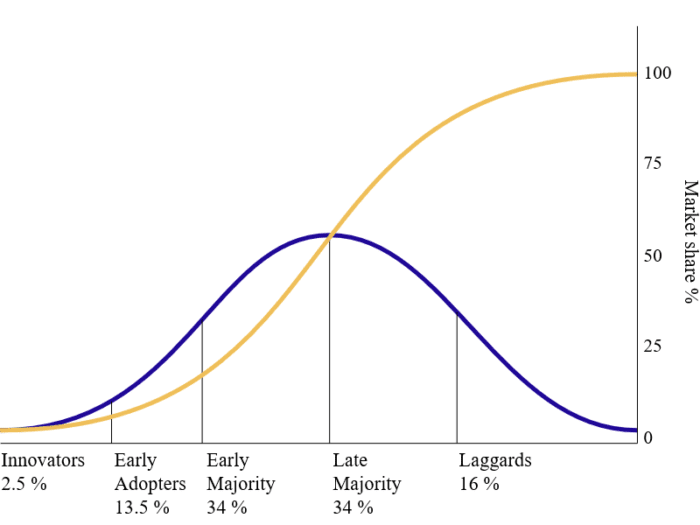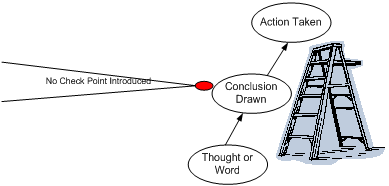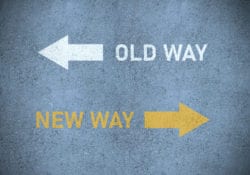Strong Point’s Leadership Rule #12: Study Learning in the Operating Environment
So often in the work of Strong Point, have I seen, or felt or heard the frustration of a customer, co-worker or colleague complaining about another’s inability to “get it.” In business transformation engagements, these slower change adopters are sometimes perceived as “less-than” professionals and are sometimes referred to as change resistors, detractors and laggards. A Change Laggard is actually an innovation adoption term and category, originally coined by Everett Rogers. Rogers, who died in 2004, was a distinguished Professor Emeritus in the Department of Communication and Journalism at the University of New Mexico. His book Diffusion of Innovation theory, first published in 1962, sought to explain how, why, and at what rate new ideas and technology spread. In his book, Rogers argued that diffusion is the process by which an innovation is communicated over time among the participants in a professional or social system.

In Strong Point’s Leadership Rule #11: Maintain an Active Innovation Lab I cite some social and scientific data that shows there’s an undeniable correlation between Innovation and Leadership. In this Strong Point Leadership Rule #12: Study Learning in the Operating Environment I’m sharing my experience that learning, specifically adult learning, is often overlooked as a key component of Leadership. I strongly believe that leaders are learners. It’s interesting to note that there’s a good body of evidence to suggest that learning, continuous learning, is key to innovation. This is why it’s important to build and nurture a learning culture to improve and advance both innovation and leadership capability.
A Dorothy Sutherland Olsen article entitled Adult Learning in Innovative Organisations and published in May of 2016 says this:
“Innovation is frequently defined as a learning processes (Lundvall, 1992, Edquist, 2001). ‘Product and process innovations are the results of learning processes such as R&D, learning‐by‐doing, learning‐by‐using and learning‐by‐interacting’ (Edquist, 2001, p. 16). Innovation is described as a gradual process whereby people, firms and nations learn from their joint attempts to solve problems and develop knowledge.”
If leaders are learners and learners are innovators, then it follows that innovators are leaders. We know this, yet as I explain in Strong Point’s Leadership Rule #5: It Matters Who. It Matters How. companies only make $1 dollar of investment in Training (this is a combined investment for Skill Building and Leadership Training) to every $5 dollars invested in technology or business capability.
I’ll go farther and say, that apart from learning and development leaders and practitioners, not enough business leaders pay enough attention to how adults learn and how learning takes place in their operating environment. As an example, how many of these adult learning tenets are you familiar with and do you regularly use to help your subordinates, co-workers, and colleagues learn? Do you realize that knowledge and practice of adult learning skills make the absorption of your thoughts, ideas, and plans by others more accessible and more memorable?

Without a good understanding of learning theory, some leaders make the mistake of thinking that the professionals in their sphere of influence working to make essential changes are willfully ignorant, non-compliant or worse, just flat-out insubordinate. A brief read of the article in the April 2001 International Journal of Educational Management called Organizational change, leadership and learning: Culture as a cognitive process, written by Gabriele Lakomski, gives rise to the complexity of how our brains are a uniquely formed set of interconnected neural nets that work in parallel processing patterns based on our specific and unique experiences. The article highlights just how hard it is for us to change and learn something new to the point of patterned behavior. She explains that we have to “unfreeze” or thaw the sometimes, life-long patterns of thoughts, behavior, and action, we hold in our heads, long enough to allow new modes of thought and practice to form and take hold. The Dalai Lama (Tenzin Gyatso) who is also an excellent study of adult learning and neuroscience, through his many writings, likens leaning and changing one’s neural patterns to jumping the embedded groves in a roadway or railroad track. He says making lasting change takes dedicated, reflective effort tantamount to beating your startle reflex. These writings give weight to how hard, and slow learning and change can be.
Additionally, a thoughtful study of adult learning theory teaches leaders, and reminds us all, how easy it is to jump to quick and erroneous conclusions when faced with disagreement or discontent from others contributing to vital plans and work. Deep reads into psychologist Chris Argyris’s work on the “Ladder of Inference” help leaders understands and remember that our brains are fantastic information optimization machines, and recognize that if they’re not careful, they’ll forget that our neural nets and patterns lead us down a nearly automatic path of thoughts, decisions, and resultant actions.

Any expert facilitator or collaborator trying to reach consensus and shared understanding will tell you that the word “collaborate” itself means a completely different and detailed thing to the twelve people working to collaborate. It is necessary to reach a common understanding of what it means to collaborate before you can collaborate effectively! Understanding the Ladder of Inference helps leaders to “check” their neural processing with others and to use their minds to review and reflect on entrenched thought patterns, filters, and biases. Understanding the Ladder of Inference also prevents leaders from immediately and negatively judging another person’s comments or actions and going off “unchecked” in a direction counter to a mutual agreement or respectful alignment.
In the same Gabriele Lakomski article referenced above (Organizational change, leadership and learning: Culture as a cognitive process) the author describes what’s necessary for groups of people to learn and change:
“…For shared learning to occur, there must be a history of shared experience, which in turn implies some stability of membership in the group. Given such stability and shared history, the human need for parsimony, consistency and meaning will cause the various shared elements to form into patterns that eventually can be called a culture…”
Strong Point calls this shared learning Team Setting. In Strong Point’s Leadership Rule #5: It Matters Who. It Matters How. and Strong Point’s Leadership Rule #9: Work with Deep People I share my belief, validated through many Strong Point engagements and experiences, that business transformations are harder and slower without first setting and then supporting a team’s shared learning and experience. Collaborating with the client leaders and groups, Strong Point adapts its methodologies and works to complement and support the customer’s culture and learning environment. This adaptive approach, informed by an awareness of adult learning strategies and theories, has lead to successful client outcomes.
It’s a constant problem all leaders face: balancing the speed of learning with the continuous need for and pace of innovation.
There are three crucial adult learning sensitivities, which I call the “Three I’s,” that Strong Point brings to any business transformation engagement or initiative.
Interactive – Clients learn by doing. Strong Point makes sure to transfer knowledge and expertise through significant client interaction. Strong Point’s service model is “high-touch.”
Iterative – Retention is mastered through “hundreds of hits” or repetition of the same content in a variety of ways, through a series of regular intervals. Strong Point’s “Time and Repetition” style enables customer teams to retain and “set” new behaviors and skills into new patterns and ways of working.
Individually Focused – Strong Point services are catered to the current skills of client professionals. Strong Point Solution Teams pay close attention to individual competencies. This allows client teams to effectively acquire new skills and change behaviors in a measured, meaningful manner that is focused on their unique capabilities.
All of the Strong Point Strategy methodologies, tools and processes, are co-created and adapted for specific learning and operating environments. It’s important to make the connection between learning and Leadership. To increase Leadership Capability follow
Strong Point’s Leadership Rule #12: Study Learning in the Operating Environment




